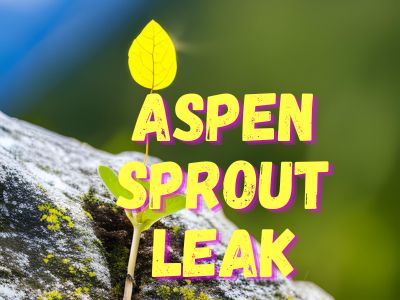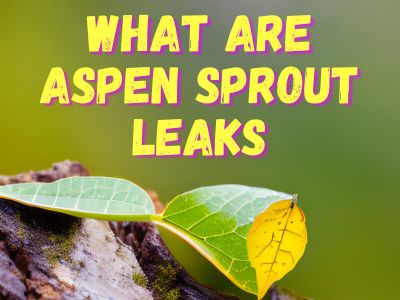An Ultimate Guide to Aspen Sprout Leaks

Have you ever noticed wet spots on the bark of your aspen tree? Perhaps you’ve seen strange fluid oozing from the branches of your aspen trees, discoloration, or wilting leaves, or maybe you’ve just had a nagging feeling that something isn’t quite right with your tree. This mysterious phenomenon, known as aspen sprout leak, can be alarming to witness. While the name itself may not be familiar, the sight of a tree with aspen sprout leaks is unmistakable.
So, if you’ve ever wondered what those strange fluids coming from your aspen trees are, keep reading to learn more about this unique and intriguing natural occurrence. Here, we will explore the causes, symptoms, effects, prevention, and treatment of aspen sprout leaks, and provide you with the information you need to keep your trees healthy and beautiful.
WHAT ARE ASPEN SPROUT LEAKS

Aspen sprout leaks are a curious phenomenon that can occur in aspen trees. It’s like they’re crying, but instead of tears, they’re leaking sap. If you’re lucky enough to live near aspen trees, you might have seen them yourself. These leaks can be a sign of something more serious, so it’s important to understand what they are and what they mean for the health of the tree.
So, what exactly are aspen sprout leaks? Well, simply put, they are leaks of sap from the tree. This sap can appear as wet spots on the bark or as a sticky residue on the ground beneath the tree. While it may look harmless, these leaks can be a sign of trouble for the tree.
Aspen sprout leaks can be caused by a variety of factors, including drought, injury, disease, or natural growth cycles. When the tree is stressed, it may release excess sap as a defense mechanism, leading to these leaks. While not all leaks are a cause for concern, it’s important to monitor them and determine if they are indicative of a larger problem.
If left untreated, aspen sprout leaks can lead to dehydration, dieback, and even death of the tree. To prevent this, it’s important to take steps to manage the underlying issue that is causing the leaks. This may involve proper watering, regular pruning, or pest and disease management.
Aspen Sprout leaks are an intriguing phenomenon that can occur in aspen trees. While they may seem harmless, they can be indicative of a larger issue that requires attention. By taking steps to manage the underlying cause of these leaks, you can help keep your aspen trees healthy and thriving for years to come.
HOW DO ASPEN SPROUT LEAKS OCCUR
Aspen sprout leaks occur due to a disruption in the intricate water transport system of the tree, which relies on specialized tissues called the xylem. The xylem is responsible for transporting water and nutrients from the roots to the rest of the tree and is made up of elongated, tube-like cells that are arranged in a long, continuous chain.
The flow of water through the xylem is driven by a combination of forces, including transpiration, which is the process by which water evaporates from the leaves, creating a negative pressure that pulls water up from the roots. When this delicate balance is disrupted, water can escape through small openings in the tree’s bark, resulting in aspen sprout leaks.
Aspen sprout leaks are a result of the complex interplay between the tree’s tissues, the environment, and external factors. By understanding the mechanisms behind aspen sprout leaks, you can better manage and prevent this issue in our trees.
WHAT ARE THE CAUSES OF ASPEN SPROUT LEAK
One common cause of aspen sprout leaks is physical damage to the tree’s bark or inner tissues. For example, pruning or accidental injury can create an opening in the bark, allowing water to escape. Additionally, pests and diseases can weaken the tree’s tissues, making them more prone to leaks.
Environmental factors can also contribute to aspen sprout leaks. Aspen trees require adequate water to thrive. During periods of drought, the tree may release excess sap through the aspen sprout leaks as a way to conserve resources. This can lead to leaks in the bark. Conversely, during periods of heavy rainfall, the pressure from excess water can cause leaks to form.
Physical damage to the tree, such as from storms, wildlife, or human activity, can also cause aspen sprout leaks. When the tree is injured, it may release sap as a way to heal itself.
Aspen trees are susceptible to a variety of diseases, some of which can cause sap to leak from the tree. One common disease that can cause aspen sprout leaks is bacterial canker.
Aspen sprout leaks may also be a natural part of the tree’s growth cycle. In the spring, as new growth appears, the tree may release excess water through aspen sprout leaks as it adjusts to the changing conditions.
Also, insects such as borers, aphids, and leafhoppers can cause damage to the tree that results in aspen sprout leaks.
HOW CAN YOU IDENTIFY ASPEN SPROUT LEAKS
If you suspect your aspen tree may have sprout leaks, it’s important to look for certain symptoms to confirm your suspicions. Here are some of the most common symptoms of aspen sprout leaks:
- Wet spots on the bark: If you notice wet spots on the bark of your aspen tree, it may be a sign of sprout leaks. These spots may appear as small droplets or larger patches of sap.
- Sticky residue on the ground: Aspen sprout leaks can also result in a sticky residue on the ground beneath the tree. This residue is the sap that has dripped from the tree.
- Yellowing or wilting leaves: If the underlying cause of the sprout leaks is a disease or pest infestation, you may notice yellowing or wilting leaves on the tree.
- Dieback: In severe cases, aspen sprout leaks can lead to dieback, or the death of branches or sections of the tree.
It’s important to note that not all wet spots on the bark are caused by aspen sprout leaks. Other factors, such as rain or irrigation, can also result in wet bark. However, if you notice any of the other symptoms listed above, it’s a good idea to take a closer look at the tree and investigate the cause of the leaks.
By monitoring your aspen trees for these symptoms, you can catch any issues early and take steps to address them before they become more serious. Regular pruning, watering, and pest and disease management can all help keep your aspen trees healthy and thriving.
WHAT ARE THE EFFECTS OF ASPEN SPROUT LEAKS
Aspen sprout leaks can have a number of negative effects on the health and vitality of your aspen trees. Here are some of the most common effects you may observe:
- Dehydration: Aspen sprout leaks can cause your tree to lose a significant amount of sap and water. This can lead to dehydration, which can be especially damaging during periods of drought.
- Nutrient loss: Sap is an important source of nutrients for aspen trees. When leaks occur, the tree may lose valuable nutrients that it needs to grow and thrive.
- Dieback: In severe cases, aspen sprout leaks can lead to dieback, or the death of branches or sections of the tree. This can weaken the overall structure of the tree and make it more susceptible to pests and disease.
- Pest and disease infestations: When the tree is weakened by sprout leaks, it may be more vulnerable to pest and disease infestations. These can further damage the tree and may require extensive management to address.
- Aesthetic issues: Aspen sprout leaks can also result in unsightly wet spots on the bark and sticky residue on the ground. This can detract from the overall appearance of your landscape and may be a nuisance to clean up.
HOW CAN YOU PREVENT ASPEN SPROUT LEAKS

Preventing aspen sprout leaks is key to maintaining the health and vitality of your trees. Here are some tips to help prevent aspen sprout leaks:
- Proper watering: Make sure your trees are receiving the right amount of water for their needs. Overwatering can lead to root rot and other issues that can contribute to sprout leaks.
- Proper pruning: Prune your trees regularly to remove dead, diseased, or damaged branches. This will promote healthy growth and reduce the risk of sprout leaks.
- Preventing damage: Take steps to prevent damage to your trees from equipment, animals, and other sources. Damage to the bark can create entry points for pests and diseases that can contribute to sprout leaks.
- Fertilization: Proper fertilization can help keep your trees healthy and reduce the risk of sprout leaks. Make sure to use the appropriate type and amount of fertilizer for your trees.
- Monitoring: Regularly monitor your trees for signs of stress, pests, and disease. Addressing these issues promptly can help prevent sprout leaks from occurring.
By following these tips, you can help prevent aspen sprout leaks and maintain the health and beauty of your trees.
HOW CAN YOU TREAT ASPEN SPROUT LEAK
If you’ve noticed aspen sprout leaks on your trees, it’s important to take action to prevent further damage and promote healing. Here are some treatments that can help:
- Trimming: Trimming the affected branches is often the first step in treating aspen sprout leaks. This can help remove damaged areas and promote healthy growth.
- Sealant application: Applying a tree sealant to the affected area can help prevent further water loss and promote healing. This is especially important in dry climates or during periods of drought.
- Fertilization: Proper fertilization can help promote healthy growth and healing in the affected tree. Make sure to use the appropriate type and amount of fertilizer for your trees.
- Pest control: If pests are contributing to the aspen sprout leaks, controlling the pest population may be necessary. Consult with a professional arborist or tree specialist for the best course of action.
- Monitoring: Regularly monitoring the affected tree for signs of stress, pests, and disease can help ensure that treatment is working and identify any additional issues that may arise.
While there are treatments available for aspen sprout leaks, prevention is always the best course of action. By following the prevention tips mentioned earlier, you can help avoid the need for treatment and maintain the health and beauty of your trees. However, if you do notice aspen sprout leaks on your trees, taking quick action can help prevent further damage and promote healing.
FREQUENTLY ASKED QUESTIONS
Do aspen sprout leaks have any impact on wildlife or other plants that are in close proximity to the affected tree?
Aspen sprout leaks can have an impact on the wildlife and other plants in close proximity to the affected tree. The leaking fluid from the tree can attract insects, which can be a food source for birds and other wildlife. However, if the leaking fluid is contaminated with harmful substances, it could also be toxic to insects, birds, and other animals that consume it. Additionally, if the leaking fluid is excessive, it could create a moist environment that is conducive to fungal growth, which could negatively impact other nearby plants.
Are there any cultural or historical uses for aspen sprout leaks in human societies?
Aspen sprout leaks do not have any significant cultural or historical uses in human societies. However, the aspen tree itself has been used for a variety of purposes throughout history. Native American tribes used aspen bark for medicinal purposes and as a building material for shelters and baskets. European settlers used the wood for furniture and papermaking.
Can aspen sprout leaks impact the overall health or quality of the soil surrounding the affected tree?
Aspen sprout leaks may have a minor impact on the overall health or quality of the soil surrounding the affected tree. The leaking fluid may contain nutrients that could be beneficial to the soil, but the impact would likely be localized to the immediate area around the tree. Additionally, if the leaking fluid is contaminated with harmful substances, it could negatively impact the soil quality.
Are there any notable cases of aspen sprout leaks causing significant damage or disruption in an urban or suburban area?
There have not been any notable cases of aspen sprout leaks causing significant damage or disruption in an urban or suburban area. Aspen trees are not commonly found in these types of environments, as they typically grow in more natural or rural settings. However, if an aspen tree were to be present in an urban or suburban area and experienced a significant sprout leak, it could potentially create a slip hazard on sidewalks or roads.
How much water can an aspen tree lose through leaks
The amount of water that an aspen tree can lose through leaks can vary depending on several factors, such as the size of the tree, the severity of the leaks, and the environmental conditions. In some cases, a single leak can result in the loss of several gallons of water per day. Over time, this can add up to a significant amount of water loss, which can be detrimental to the overall health and survival of the tree.
Does Aspen Sprout Leak cause disease In human
While aspen sprout leaks are not known to cause disease in humans, it’s crucial to exercise caution when handling these trees. The sap of some trees, including aspens, can be irritating to the skin and may even trigger an allergic reaction in certain individuals. If you happen to come into contact with the sap, you’ll want to immediately wash the affected area with soap and water, avoiding touching your eyes or mouth. In the event that you experience a rash, itching, or other concerning symptoms, seek medical attention right away.
It’s also important to note that consuming any part of the aspen tree is ill-advised, as some species may contain toxic compounds. While aspen sprout leaks themselves may not pose a direct threat to human health, it’s still essential to be mindful of potential risks when dealing with these trees.
LAST BUT NOT THE LEAST
Aspen sprout leaks are a natural and often inevitable part of a tree’s life cycle. Understanding the causes and symptoms of these leaks is crucial for ensuring the health and longevity of our trees.
Remember, the key to maintaining healthy trees is to stay vigilant and proactive. Regular tree inspections and care can go a long way in preventing aspen sprout leaks and other issues from occurring. So, whether you’re a homeowner, landscaper, or tree care professional, make sure to keep an eye out for signs of aspen sprout leaks and take action to keep your trees healthy and strong.
By following these simple tips and working to prevent and treat aspen sprout leaks, you can help to ensure that your trees remain beautiful, vibrant, and healthy for generations to come.



